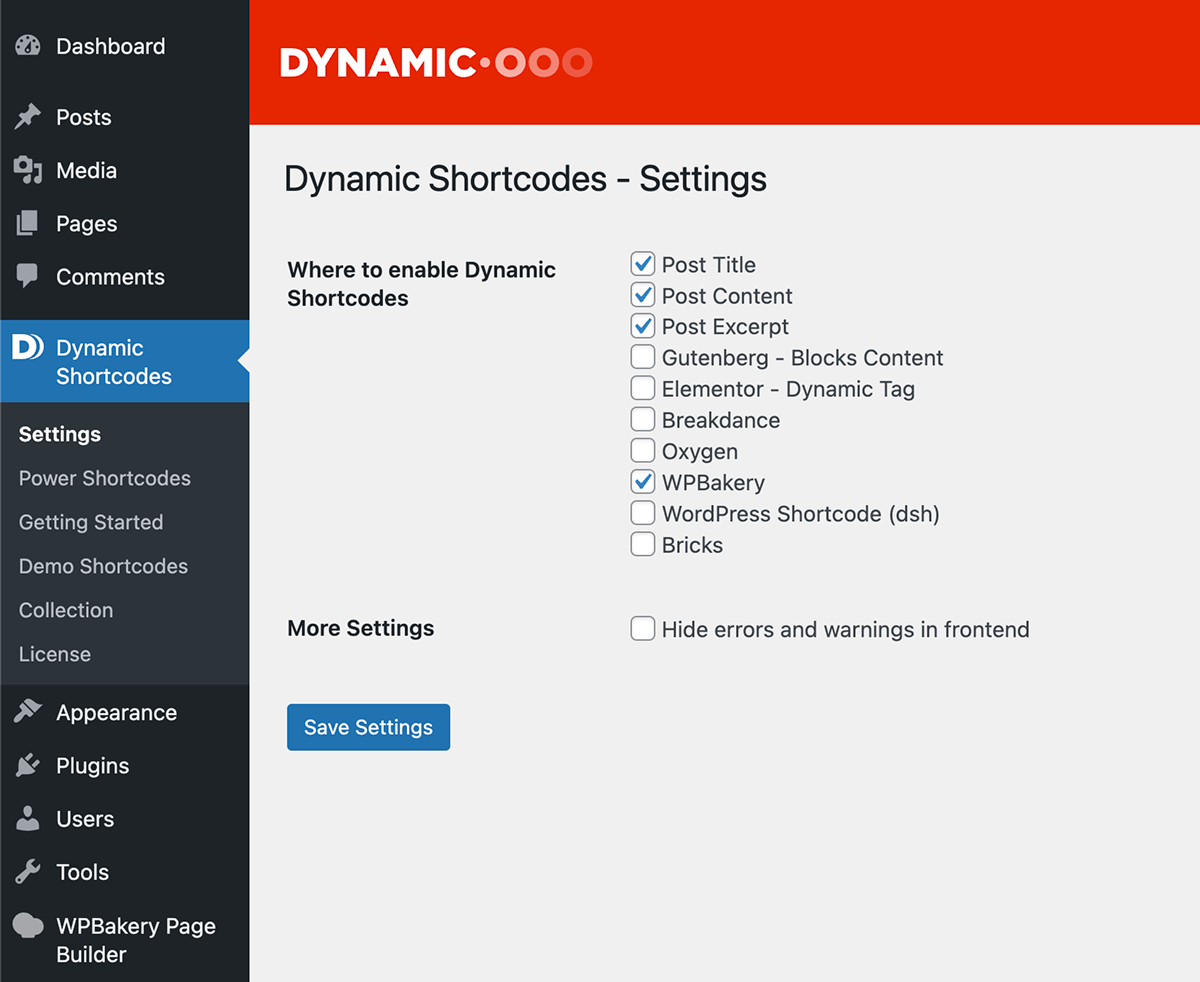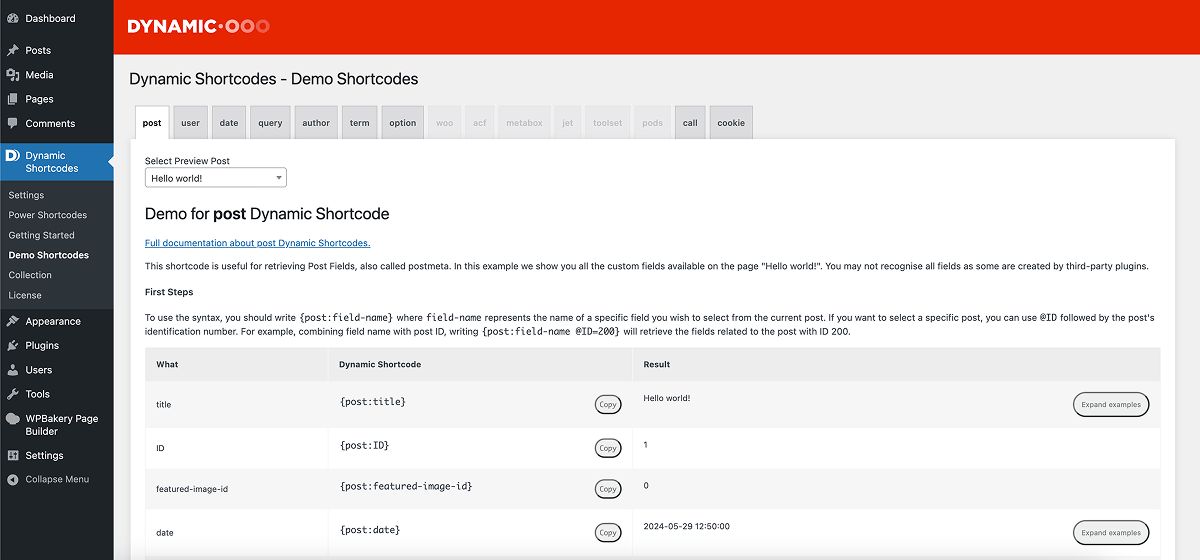Dynamic Shortcodes: Bringing data-driven content to WPBakery
If you build with WPBakery and want your content to feel truly “alive,” Dynamic Shortcodes is one of those tools that changes how you work.
Created by Dynamic.ooo , it lets you read and transform WordPress data directly inside your element fields – no custom coding required.
The outcome – smarter pages, consistent content, and faster maintenance.
What Dynamic Shortcodes is (in practice)
Dynamic Shortcodes provides a simple brace-based syntax that “pulls” information from posts, users, taxonomies, site options, and popular integrations like ACF, Pods, Toolset, WooCommerce, and more.
Inside WPBakery, it’s transparent – enable the plugin’s WPBakery option (available from the Dynamic Shortcodes version 1.6) and, from that moment on, your elements can accept these mini‑commands between curly braces.

Why agencies and creators love it
If you produce lots of pages, you’ll appreciate the time and error reduction – update the right source once and see it reflected everywhere, without juggling multiple screens.
Editors also benefit – no ad‑hoc snippets – just a coherent, predictable way to output titles, excerpts, links, custom fields, featured images, and any data you need for clean interfaces.
Turning it on in WPBakery (two quick steps)
- Open Dynamic Shortcodes settings from your WordPress dashboard and enable the WPBakery option. When WPBakery is present, your element content is processed by Dynamic Shortcodes.
- Then paste Dynamic Shortcodes directly in the WPBakery editor (in Text Block or Raw HTML element) and preview – you’ll see live values replacing placeholders.
A quick taste of the syntax (just to get oriented)
The typical shape is {type:args@options|filters?fallback}.
For example, the current post title is {post:title}, a trimmed excerpt is {post:excerpt|wp_trim_words(20)}, and the permalink is {post:permalink}.
The same applies to taxonomies {term:name} and users {user:display_name}. These are basic examples – Dynamic Shortcodes is far more powerful, as the advanced section below shows.
Note: You can find a full list of available shortcodes under Dynamic Shortcodes → Demo Shortcodes in your WordPress dashboard.

From simple to advanced: Where Dynamic Shortcodes shines
This is where composition pays off and you start building rich, reusable blocks.
- ACF repeater, made readable: If you have a “features” repeater, you can turn it into a compact, safe HTML list:
{acf-loop:features [<li>{acf:name} — {acf:quantity}] @sep=", "}This iterates the repeater rows and prints the name and quantity for each; sep controls the separator.
- ACF relationship, linking posts properly: When a relationship field stores related post IDs, you can generate a clean list of correct links in seconds:
{acf-loop:related_posts [<li><a href="{post:permalink}">{post:title}</a>] @sep=""}Under the hood, Dynamic Shortcodes sets the right post context for each ID, so {post:…} reads the correct post on each pass.
- WooCommerce pricing with offer logic: To show the right price for the current product, use {woo:price}. If a sale price exists, decide dynamically what to print:
{if:{woo:sale-price} {woo:sale-price} {woo:price}}Need a specific product’s price? Use its ID: {woo:price@id=123}.
- WooCommerce orders at a glance: To list the latest completed orders, start from a focused query and render them your way:
{query:woo-orders@status=completed}
Everyday use (hero and cards)
A common pattern in WPBakery sites is the Hero section is – current post title {post:title}, a short summary {post:excerpt|wp_trim_words(20)}, and a CTA to the permalink {post:permalink}. It remains consistent even when you duplicate the section for other content.
The same approach applies to content cards – featured image URL {media:url @ID={post:featured-image-id}}, title, and link. The layout stays identical while the data updates itself.
 Examples for quick inspiration
Examples for quick inspiration
- Query by meta (e.g., event_date):
{query:posts@meta_key=event_date meta_value="2023-12-01"} - List terms for the current post:
{post:terms@taxonomy=category} - Cache and reuse (performance):
{cache:latest_articles {query:posts@posts_per_page=50} @expiration="1 hour"} - User roles as a list (loop):
{for:value {user:roles} [<li>{get:value}] }
Try out Dynamic Shortcodes for yourself
Dynamic Shortcodes lets your data speak to your WPBakery layout without friction. From tiny details (a title that’s always right) to richer scenarios (ACF repeaters, relationships, recent orders), the workflow stays simple – write once, reuse everywhere. And as your project grows, these “smart blocks” are the difference between a site that’s easy to run and one that needs constant manual fixes.
Best of all, all WPBakery customers can get Dynamic Shortcodes at 20% off in the Customer Center. And if that isn’t enough to convince you, they also offer a 30-day money-back guarantee.

